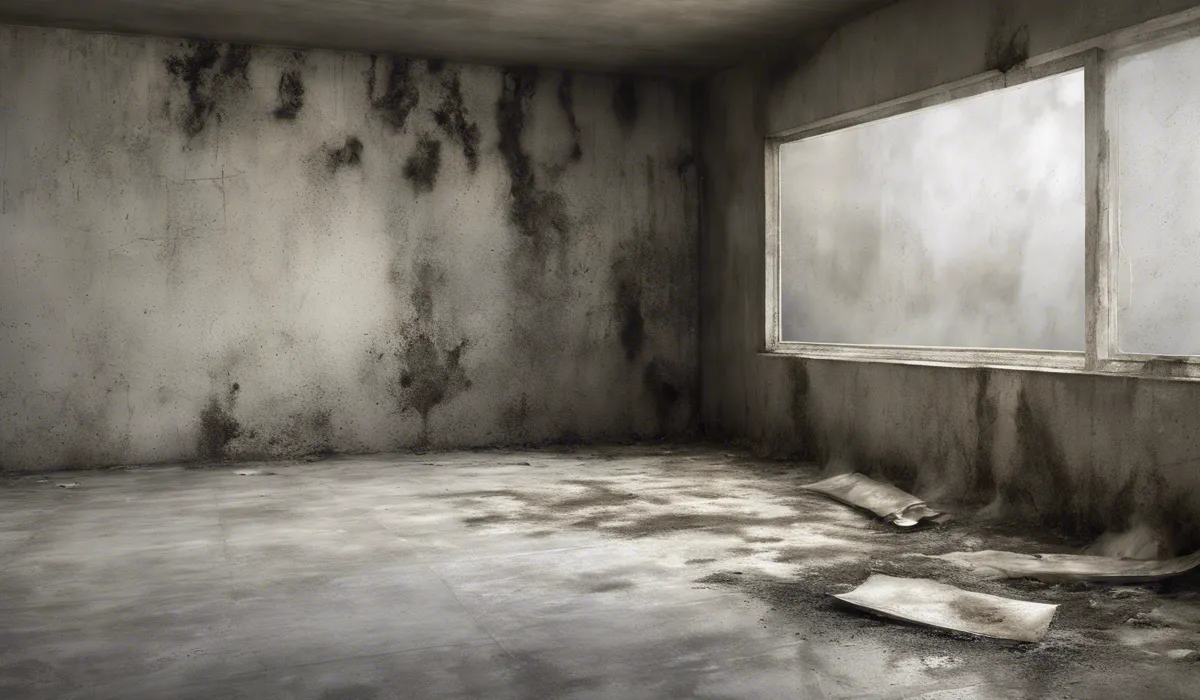Mold on concrete can be dangerous as it may cause respiratory issues and allergic reactions, especially in sensitive individuals. It’s not inherently toxic but can harbor harmful bacteria. Removing mold promptly from concrete surfaces is advisable to prevent health risks.
Understanding Mold on Concrete

Definition and Characteristics of Mold
Mold is a type of fungus that can grow both indoors and outdoors. It thrives in warm, damp, and humid conditions.
Mold on concrete appears as a patchy discoloration that might be green, black, white, or even red. It spreads by releasing tiny spores into the air, which can land and grow on surfaces when the conditions are right.
Mold is not just unsightly; it can also damage the materials it grows on by breaking down their structure.
Conditions That Promote Mold Growth on Concrete
Concrete might seem like an unlikely place for mold to grow, but it can happen if the conditions are right.
Mold on concrete is usually due to moisture problems. Concrete can absorb water, which makes it damp. If this moisture does not dry out, it creates an environment where mold can grow.
Poor ventilation and dark areas further encourage mold growth, as does the presence of organic material on the concrete, like leaves or dirt.
Types of Mold Commonly Found on Concrete Surfaces
There are several types of mold that you might find on concrete surfaces.
Some of the most common include Alternaria, which is often found outdoors and has a velvety texture with dark green or brown hairs; Cladosporium, which is brown, green, or black and can survive in cooler temperatures; and Penicillium, which usually appears blue or green and can spread quickly.
While these are among the most common, many other types of mold can also grow on concrete.
Health Implications of Mold Exposure

Overview of Health Risks Associated with Mold Exposure
Exposure to mold can lead to various health issues. Breathing in mold spores may cause allergic reactions, asthma attacks, and other respiratory problems.
Some people might experience symptoms like sneezing, runny nose, red eyes, and skin rash.
Mold exposure can also lead to more serious health problems, such as lung infections, especially in people with weakened immune systems.
Specific Health Concerns Related to Mold on Concrete
While mold on concrete is not inherently toxic, it can harbor harmful bacteria. When mold grows on concrete, especially in areas like basements or garages, it can release spores that contaminate the air quality.
These spores can be inhaled and lead to the health issues mentioned earlier. Therefore, even though the concrete itself does not pose a health risk, the mold growing on it can be a concern.
Vulnerable Populations and Symptoms to Watch For
Certain groups of people are more vulnerable to the effects of mold. These include infants and young children, the elderly, individuals with allergies or asthma, and those with compromised immune systems.
Symptoms that might indicate a reaction to mold exposure include persistent coughing, difficulty breathing, wheezing, headaches, fatigue, and in severe cases, fever or chest tightness.
If anyone experiences these symptoms and mold is present in their environment, they should seek medical attention.
Prevention and Remediation Strategies

Best Practices for Preventing Mold Growth on Concrete
To prevent mold growth on concrete, it is essential to keep the area dry and well-ventilated.
Use dehumidifiers in damp areas and ensure good air circulation. Fix leaks promptly, and remove sources of water like standing puddles or dampness.
Clean surfaces regularly to remove organic material that mold can feed on. Using mold inhibitors in paints can also help prevent mold growth on painted concrete surfaces.
Step-by-Step Guide for Removing Mold from Concrete Surfaces
To remove mold from concrete surfaces, start by wearing protective gear like gloves, masks, and goggles.
Scrub the area with a stiff brush and a mixture of water and dish soap or a commercial mold removal product. For tougher mold, use a mixture of one part bleach to four parts water, but ensure the area is well-ventilated.
Rinse the area thoroughly with water after cleaning and dry it quickly to prevent mold from returning.
When to Seek Professional Help for Mold Remediation?
If the moldy area is large or if the mold keeps coming back after cleaning, it may be time to seek professional help.
Mold remediation professionals have the tools and expertise to remove mold safely and effectively.
They can also help identify and fix the underlying moisture problem that caused the mold to grow in the first place.
When health is at stake, especially for vulnerable populations, professional remediation is advisable.
FAQs About Mold on Concrete
Is mold on concrete dangerous for health?
Yes, mold on concrete can be dangerous as it may cause respiratory issues and allergic reactions, particularly in individuals with sensitivities.
Can mold on concrete be toxic?
Mold itself is not inherently toxic, but it can harbor harmful bacteria which may pose health risks.
Should I remove mold from concrete surfaces immediately?
Yes, it is advisable to remove mold promptly from concrete surfaces to minimize potential health risks.
What are the signs that mold on concrete is affecting my health?
Signs that mold may be affecting your health include respiratory issues, allergic reactions, and other symptoms such as coughing, wheezing, or skin irritation.
Is it safe to clean mold off concrete by myself?
It can be safe to clean mold off concrete yourself if you take appropriate precautions, such as wearing protective gear and ensuring good ventilation, but it’s important to address the underlying moisture issue to prevent recurrence.
Final Thoughts
Mold on concrete can pose health risks, such as respiratory problems and allergic reactions, especially for those with sensitivities.
While not toxic itself, mold can foster bacteria that are harmful. It is essential to address and remove mold from concrete surfaces quickly to mitigate potential health dangers.
